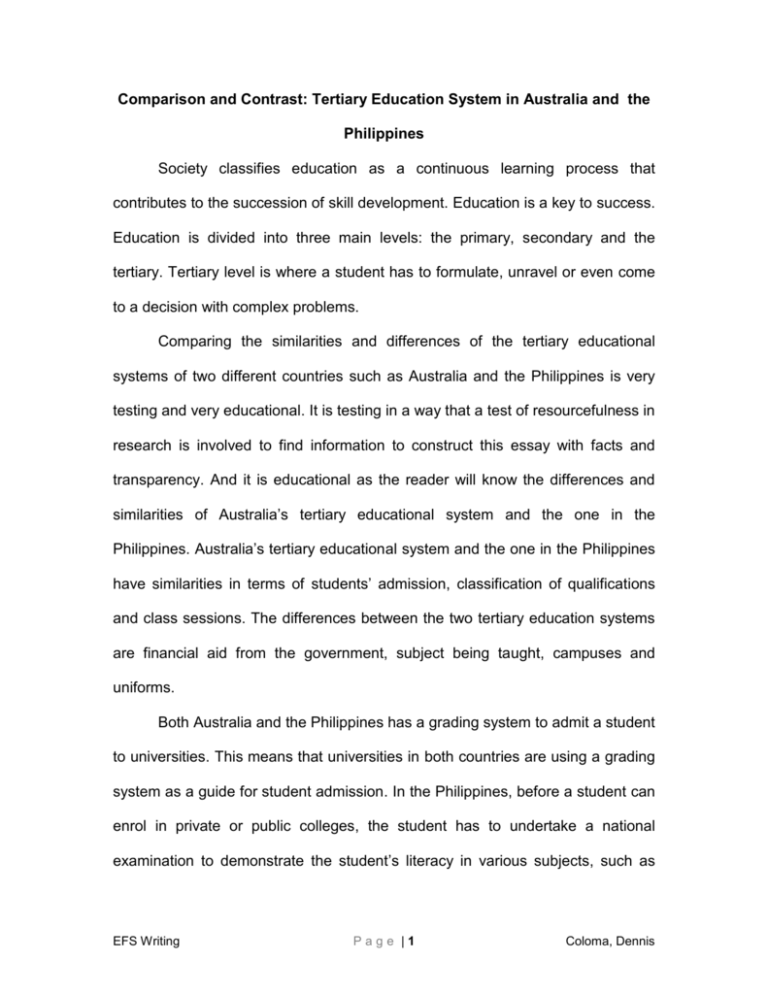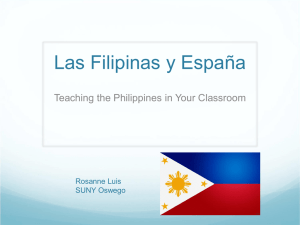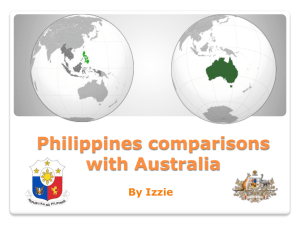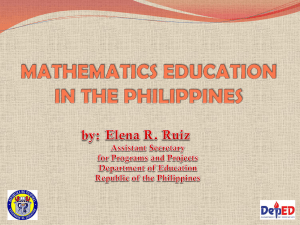Comparison and Contrast of Education System in Australia
advertisement

Comparison and Contrast: Tertiary Education System in Australia and the Philippines Society classifies education as a continuous learning process that contributes to the succession of skill development. Education is a key to success. Education is divided into three main levels: the primary, secondary and the tertiary. Tertiary level is where a student has to formulate, unravel or even come to a decision with complex problems. Comparing the similarities and differences of the tertiary educational systems of two different countries such as Australia and the Philippines is very testing and very educational. It is testing in a way that a test of resourcefulness in research is involved to find information to construct this essay with facts and transparency. And it is educational as the reader will know the differences and similarities of Australia’s tertiary educational system and the one in the Philippines. Australia’s tertiary educational system and the one in the Philippines have similarities in terms of students’ admission, classification of qualifications and class sessions. The differences between the two tertiary education systems are financial aid from the government, subject being taught, campuses and uniforms. Both Australia and the Philippines has a grading system to admit a student to universities. This means that universities in both countries are using a grading system as a guide for student admission. In the Philippines, before a student can enrol in private or public colleges, the student has to undertake a national examination to demonstrate the student’s literacy in various subjects, such as EFS Writing Page |1 Coloma, Dennis mathematics, science, English subjects, Filipino and Araling Panlipunan. National Secondary Achievement Test known as NSAT in 1990’s and now is called National Achievement Test. Students who could reach 75% or up are competent, while 50% or below shows inadequacy of the learned subject. Australia has a similar national test known as High School Certificate or HSC for short. Students who wish to enrol in university should undertake the test. A course such as medicine and laws would require a higher HSC mark. School types are very similar in both private and public universities in both countries. Private universities in the Philippines are either ‘sectarian’ or ‘nonsectarian’. Most private universities are catholic colleges such as Ateneo de Manila University (Jesuit) and University of Sto Thomas (Dominican). Siliman University (Protestant) and Trinity University of Asia (Anglican) are non-sectarian. Australia has one catholic university (Australian Catholic University), which is funded buy the Australian government. Public universities in the Philippines are divided into two groups: (a) the state universities and colleges: (b) the local colleges and universities. Whilst in Australia, there are 39 public universities such as the University of New South Wales (UNSW), the University of Sydney and the University of Technology Sydney (UTS). Australia has 2 private universities the Bond University in Wagga Wagga and the University of Notre Dame. TAFE (Technical and Further Education), on the other hand, is the only national provider of both vocational courses and skilled training programmes so far. Classifications of qualifications in the Philippines are very similar to the ones provided by the Australia’s tertiary educational system. Both offer a EFS Writing Page |2 Coloma, Dennis Bachelor Degree within a four year course. Masteral and Doctoral Degree are for another two years. Some private institutions in both countries can offer a two year certificate or diploma courses. TAFE colleges offer a diploma course such as information technology and some skill enhancing courses. Similarly public colleges in the Philippines such as BCAT (Bicol Colleges of Arts and Trades) also offer diploma and graduate courses teaching engineering and mechanical skills. Class sessions in the Philippines vary, depending on subjects’ availability and students’ flexibility. Those students who wish to attend a class in the morning, or afternoon, or in the evening class should enrol with the corresponding subjects. Summer class sessions are offered in most of the universities in the Philippines. In Australia similar class sessions are presented. Despite the above mentioned similarities between the Australian tertiary education system and the one in the Philippines, there are differences when it comes to the government funding, subjects, campuses and uniforms. The government funding has an enormous impact on the tertiary education system in each country. Education is regarded as a very important aspect of their life in Australia. That is why the government tries to support its students with financial aid such as HECS, which means that an applicant can study first and repay later to HECS. In addition, AUSTUDY and Youth Allowances and some other form of scholarships are offered in some universities. Whereas, in Philippine the government only concentrates on the major state universities. The University of the Philippines and other major universities around EFS Writing Page |3 Coloma, Dennis metro Manila stand a chance to receive a colossal amount of funding. Scholarships are granted to brilliant students. Subjects taught in the Philippine universities completely focus on mandated subjects, for instance life and works of Dr. Jose Rizal (the national hero of the country), three subjects of Filipino language, basic math and science, and Filipino cultural. Whereas in Australia it is diverse, TAFE, for instance, focalizes its courses on developing or enhancing students’ skills. Some college campuses in the Philippines have three educational levels namely primary, secondary and tertiary. They are in one campus. The University of Nueva Caceres is one of such example. While in Australia, it is different as these three levels are put on separated campuses. In terms of uniform, major catholic universities in the Philippines are on compulsory uniform policy. Such example is the Universidad de Sta Isabel. Australian tertiary colleges do not oblige their students to wear uniform. Although there are differences between the Australia’s tertiary education system and the one in the Philippines in terms of government funding, subjects, campuses and uniforms. There are similarities in terms of students’ admission, classification of qualifications and class session. There is a hope in pursuing a good education no matter what the circumstances are or which country a person happens to be. No matter what the barriers are, there is always a way to get a good education. It is up to an individual’s eagerness and yearning for education to pursue higher level of education. EFS Writing Page |4 Coloma, Dennis Point of Similarities and Differences Entrance Test or Admission of Students before enrolling in university Types of School Classification of Qualification for public and private institution or universities Class session on public and private Financial aids from government Subjects being thought Philippines Australia Same or Different National Secondary Achievement Test (NSAT) 1990 National Achievement Test Private and Public University Associates, Certificate and Diploma’s offered in private and public institution 2 year course Bachelor Degree 4 year course Masteral Degree 2 year course Doctoral Degree 2 year course Morning Class Evening Class Afternoon Class Summer Class Private university and institution are not funded by government Public university funded by government but huge budget in major university Scholarships Mandated subject High School Certificate (HSC) Same Private and Public University Certificate and Diploma offered in TAFE 2 year course Bachelor Degree 4 year course Masteral Degree 2 year course Doctoral Degree 2 year course Same Same Morning Class Evening Class Afternoon Class Same except for summer class Private and public university such as TAFE are funded by Australian government Financial aids like HECS, AUSTUDY and Youth Allowances Major subjects and developing of student skills Separated campuses No uniform Different Campus and uniforms Three levels of education system are in one campus Compulsory uniforms in Catholic university EFS Writing Page |5 Coloma, Dennis Different Different OUTLINE Topic: Comparison and Contrast: Tertiary Education System in Australia and the Philippines I. Introduction and Definition II. Similarities A. Entrance test or Admission of Student a. NSAT or NAT and HSC B. Classification of Qualification a. both are similar in term of classifying the students’ qualification C. Class Session a. morning, afternoon and evening class b. summer class in the Philippines III. Differences A. Financial aid from the government a. Philippines only concentrate on major universities in Manila b. Australian universities are funded by government B. Subjects being thought a. mandated subjects on Philippines universities b. TAFE focus on skills and vocational C. Campuses and Uniforms a. three level of universities are in one school in the Philippines EFS Writing Page |6 Coloma, Dennis








